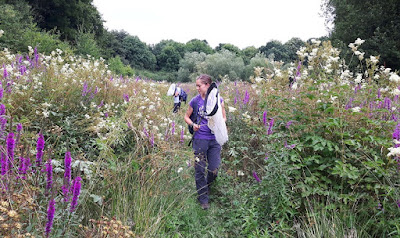Firstly. some BIG news....
We did it!!
Hannah Deacon, myself and Tom Simpson
The organisation CIRIA firmly believes that the construction industry, business and infrastructure can all do their part in preserving the UK's biodiversity. In the midst of unprecedented species decline and the loss of British countryside, this is becoming of vital importance in conservation.
Betony in flower along the River Mole, North West Zone (July 2016)
Summer conservation and habitat works:
We are incredibly grateful to all of our volunteers who have visited the sites and got stuck in this summer, as without you we would not have half a project! We've spent days with local businesses and Gatwick staff controlling Himalayan Balsam along rivers, managing glades in ancient woodlands and helping to fortify the woodland footpaths.
Himalayan Balsam flying through the air
Working along the River Mole in Gatwick Airport's North West Zone
Kevin Lerwill's regular team of Gatwick Greenspace volunteers make a great contribution to our sites, along with Tom's regular helpers, Harry and Robert, who are incredibly helpful on more technical tasks. Here they have installed a shiny new biodiversity information board, over at the Land East of the Railway Line.
Under no circumstances may we put any staples for posters in the new oak frames
...oops.
At the North Terminal Staff Memorial Garden; our pollinator friendly plants are filling out the spaces nicely, with signposts in place displaying information about each plant. Next year we will begin recording the pollinating insects here for the Sussex University LASI 'Plants for pollinators' study!
Jubilee Staff Memorial Garden - planting for pollinators
Tom Simpson with Sussex Wildlife Trust conservation trainee Bruno
Bumblebee on Hemp Agrimony (Eupatorium cannabinum)
Ecological monitoring:
Two new surveys conducted this year were clearwing moths and Purple Emperor Butterflies. Clearwing moths can be tracked down with the use of specific pheromone lures, which we bought from Anglian Lepidopterist Supplies.
Our first crack at using clearwing moth pheromones
It was rather challenging to even find a sunny afternoon in June and July! After a few attemps, our work experience placement student Ellie was our lucky charm and behold, after just 5 minutes the Sallow Clearwing Moth did appear!
Sallow Clearwing Moth (Synanthedon flaviventris)
We had no joy trying to tempt down Purple Emperor Butterflies from Oak canopies, despite using some incredibly stinky shrimp paste (apparently the males love to feed on noxious substances). However, with keen-eyed ecology volunteers like Ellie and Ryan, you don't always need a lure...
A White Admiral perhaps? But we can just make out two tiny eyespots...
Thanks to Ryan's netting skills (and a local resident for supplying an extendable pole and gaffer-tape), we were able to get a closer look to confirm our identification...
Large indicative eye spot on the underside of the upper wing
Purple Emperor (Apatura iris) female, one of Britain's biggest butterfly species
This is another fantastic record for the airport! Finger crossed that next year we hope to photograph the male.
Happy surveyors
Not only have we had new invertebrate species this year, but vertebrates too! Our very first Slow-worm has turned up in the Land East of the Railway Line. This is a bit of a landmark moment, as in over 4 years of continuous monitoring the only reptile species recorded at Gatwick has been Grass Snakes. Wildlife photographer David Plummer visited our site last week, turned over the first reptile mat he came to and found a new species!
A coppery flash...
Slow-worm (Anguis fragilis) 'The Flash', eventually caught yesterday by myself and Ellie
Back to Gatwick's Grass Snakes, and we've had good results on our surveys this year, with several more sightings of these incredible melanistic (all black) specimens...
Grass Snake (Natrix natrix) melanistic form
Juvenile with the barest hint of a yellow collar, but otherwise entirely black.
The DNA samples we collect will be sent off to Bangor University for further analysis. Their study will be looking at relatedness of unusually coloured Grass Snake to other populations around the UK and the European sub-species.
Sleepy Brown Long-eared Bat (Plecotus auritus) waits patiently while having his box cleaned out
After our final bat box checks for 2016 (I think we now have around 75 boxes in total), we have confirmed Brown Long-eareds, Common Pipistrelle and Soprano Pipistrelle all in residence.
Ellie and Ryan on a beewalk survey along the River Mole
Rina Quinlan assisting on our reptile surveys
Tom Forward and Ellie on our breeding bird survey
We've hosted a wildlife week, a wildlife day, monitored a whole suite of protected species, recorded declining invertebrates, conducted ecology training courses and natural history group meetings, with many experts giving up their valuable time to help uncover Gatwick's diversity of species. As we go into autumn the work doesn't stop, with more ecological monitoring and habitat works yet to come!
A final big thank you to Royal Holloway University Ecology placement student Ellie Stradling for all her time, commitment and wildlife charming skills this past summer. Please come back again soon!
Ellie and a Southern Hawker Dragonfly (Aeshna cyanea)





























